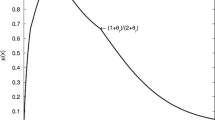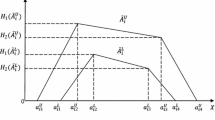Abstract
The main objective of this investigation is to propose a defuzzification process of a trapezoidal type-2 fuzzy variable centred on critical value-based reduction method and nearest interval approximation, i.e. \(\alpha \)-cut of fuzzy number. In this context, this paper proposes some theorems with proof. Also as an application of the proposed defuzzification process, a new multi-objective green solid transportation model has been formulated with all of its parameters as trapezoidal type-2 fuzzy variables, where the objectives are profit maximization and minimization of carbon emission produced by the modes of transport depending upon their loads, fuel type used, type of engine, driving characteristics, etc. After defuzzification, to solve the equivalent crisp multi-objective solid transportation problem the intuitionistic fuzzy programming technique is used. Also we have proposed the MOGA and LINGO 13.0 iterative platform for the soft computation related to the problem. At the end, proposed methodologies are finally illustrated by providing numerical examples which incorporate some real-life data and demonstrate how a decision maker makes a balance between the maximum profit and minimum carbon emission. Also a comparative study with N–T method has been provided, and some managerial decisions are drawn.

Similar content being viewed by others
Explore related subjects
Discover the latest articles, news and stories from top researchers in related subjects.References
Aliev RA, Pedrycz W, Guirimov B, Aliev RR, Ilhan U, Babagil M, Mammdli S (2011) Type-2 fuzzy neural networks with fuzzy clustering and differential evolution optimization. Inf Sci 181(9):1591–2160
Bector CR, Chandra S (2005) Fuzzy mathematical programming and fuzzy matrix games. Springer, Berlin
Buckley JJ, Eslami E (2002) An introduction to fuzzy logic and fuzzy sets. Physica-Verlag, Heidelberg
Chaabane A, Ramudhin A, Paquet M (2012) Design of sustainable supply chains under the emissions trading scheme. Int J Prod Econ 135:37–49
Chakraborty S, Pal M, Nayak PK (2013) Intuitionistic fuzzy optimization technique for pareto optimal solution of manufacturing inventory models with shortages. Eur J Oper Res 228:381–387
Chen SM, Lee LW (2010) Fuzzy multiple criteria hierarchical group decision-making based on interval type-2 fuzzy sets. IEEE Trans Syst Man Cybern Part A: Syst Hum 40(5):1120–1128
Chen SM, Lee LW (2010) Fuzzy multiple attributes group decision-making based on the ranking values and the arithmetic operations of interval type-2 fuzzy sets. Expert Syst Appl 37(1):824–833
Chen Y, Zhang L (2011) Some new results about arithmetic of type-2 fuzzy variables. J Uncertain Syst 5(3):227–240
Coupland S, John R (2008) A fast geometric method for defuzzification of type-2 fuzzysets. IEEE Trans Fuzzy Syst 16(4):929–941
Das SK, Goswami A, Alam SS (1999) Multi-objective transportation problem with interval cost, source and destination parameters. Eur J Oper Res 117:100–112
Das A, Bera UK, Maiti M (2016) Defuzzification of trapezoidal type-2 fuzzy variables and its application to solid transportation problem. J Intell Fuzzy Syst 30:2431–2445
Das A, Bera UK, Das B (2016) A solid transportation problem with mixed constraint in different environment. J Appl Anal Comput 6(1):179–195
Das A, Bera UK, Maiti M (2016) A breakable multi-item multi stage solid transportation problem under budget with Gaussian type-2 fuzzy parameters. Appl Intell 45(3):923–951
Greenfield S, Chiclana F, John RI, Coupland S (2012) The sampling method of defuzzification for type-2 fuzzy sets: experimental evaluation. Inf Sci 189:77–92
Greenfield S, Chiclana F (2013) Defuzzification of the discretised generalised type-2 fuzzy set: experimental evaluation. Inf Sci 244:1–25
Grzegorzewski P (2002) Nearest interval approximation of a fuzzy number. Fuzzy Sets Syst 130:321–330
Haley KB (1962) The solid transportation problem. Oper Res Int J 10:448–463
John RI (1998) Type-2 fuzzy sets: an appraisal of theory and applications. Int J Uncertain Fuzziness Knowl Based Syst 6(6):563–576
Karmakar S, Bhunia AK (2014) An alternative optimization technique for interval objective constrained optimization problems via multi-objective programming. J Egypt Math Soc 22:292–303
Karnik NN, Mendel JM (2001) Centroid of a type-2 fuzzy set. Inf Sci 132:195–220
Karnik NN, Mendel JM (2001) Operations on type-2 fuzzy sets. Fuzzy Sets Syst 122:327–348
Konur D (2014) Carbon constrained integrated inventory control and truckload transportation with heterogeneous freight trucks. Int J Prod Econ 153:268–279
Kundu P, Kar S, Maiti M (2013) Multi-objective multi-item solid transportation problem in fuzzy environment. Appl Math Model 37:2028–2038
Kundu P, Kar S, Maiti M (2014) Multi-objective solid transportation problems with budget constraint in uncertain environment. Int J Syst Sci 45(8):1668–1682
Kundu P, Kar S, Maiti M (2014) Fixed charge transportation problem with type-2 fuzzy variables. Inf Sci 255:170–186
Kundu P, Kar S, Maiti M (2015) Multi-item solid transportation problems with type-2 fuzzy parameters. Appl Soft Comput. doi:10.1016/j.asoc.2015.02.007
Ling X, Zhang Y (2011) Operations on triangle type-2 fuzzy sets. Procedia Eng 15:3346–3350
Liu F (2008) An efficient centroid type-reduction strategy for general type-2 fuzzy logic system. Inf Sci 178:2224–2236
Liu P, Yang L, Wang L, Li S (2014) A solid transportation problem with type-2 fuzzy variables. Appl Soft Comput 24:543–558
Liu B, Iwamura K (1998) Chance constrained programming with fuzzy parameters. Fuzzy Sets Syst 94(2):227–237
Liu ZQ, Liu YK (2010) Type-2 fuzzy variables and their arithmetic. Soft Comput 14:729–747
Mendel JM (2007) Advances in type-2 fuzzy sets and systems. Inf Sci 177:84–110
Mendel JM, John RIB (2002) Type-2 fuzzy sets made simple. IEEE Trans Fuzzy Syst 10(2):117–127
Mizumoto M, Tanaka K (1981) Fuzzy sets of type-2 under algebraic product and algebraic sum. Fuzzy Sets Syst 5:277–290
Nie M, Tan WW (2008) Towards an efficient type-reduction method for interval type-2 fuzzy logic systems. In: 2008 IEEE International Conference on Fuzzy Systems (FUZZ 2008), pp 1425–1432
Ojha A, Das B, Mondal S, Maiti M (2009) An entropy based solid transportation problem for general fuzzy costs and time with fuzzy equality. Math Comput Model 50(1–2):166–178
Ojha A, Das B, Mondal S, Maiti M (2010) A solid transportation problem for an item with fixed charge, vehicle cost and price discounted varying charge using genetic algorithm. Appl Soft Comput 10:100–110
Pan S, Ballot E, Fontane F (2013) The reduction of greenhouse gas emissions from freight transport by pooling supply chains. Int J Prod Econ 143:86–94
Qin R, Liu YK, Liu ZQ (2011) Methods of critical value reduction for type-2 fuzzy variable and their applications. J Comput Appl Math 235:1454–1481
Safi MR, Razmjoo A (2013) Solving fixed charge transportation problem with interval parameters. Appl Math Model 37:8341–8347
Sakawa M (1983) Interactive computer program for fuzzy linear programming with multiple objectives. Int J Man Mach Stud 18:489–503
Shaocheng T (1994) Interval number and fuzzy number linear programming. Fuzzy Sets System 66:301–306
Shell E (1955) Distribution of a product by several properties. In: Directorate management analysis, proceeding of the second symposium in linear programming, vol 2, pp 615–642, DCS/Comptroller H. Q. U. S. A. F
Sinha B, Das A, Bera UK (2016) Profit maximization solid transportation problem with trapezoidal interval type-2 fuzzy numbers. Int J Appl Comput Math. doi:10.1007/s40819-015-0044-8
Soysal M, Bloemhof-Ruwaard JM, van der Vorst JGAJ (2014) Modelling food logistics network with emission considerations: the case of an international beef supply chain. Int J Prod Econ 152:57–70
Srivastava SK (2007) Green supply-chain management: a state-of-the-art literature review. Int J Manag Rev 9:53–80
Sundarakani B, de Souza R, Goh M, Wagner SM, Manikandan S (2010) Modeling carbon footprints across the supply chain. Int J Prod Econ 128:43–50
Vignaux GA, Michalewicz Z (1991) A genetic algorithm for the liner transportation problem. IEEE Trans Syst Man Cybern 21(2):445–452
Wang P (1982) Fuzzy contactability and fuzzy variables. Fuzzy Sets Syst 8:81–92
Wu HC (1999) The central limit theorems for fuzzy random variables. Inf Sci 120:239–256
Yang PY, Tang JF, Yu Y, Pei JX (2013) Minimizing carbon emissions through vehicle routing and scheduling in the shuttle service of picking up and delivering customers to the airport. Acta Autom Sin 39(4):424–432
Yang L, Feng Y (2007) A bicriteria solid transportation problem with fixed charge under stochastic environment. Appl Math Model 31:2668–2683
Yang L, Liu L (2007) Fuzzy fixed charge solid transportation problem and algorithm. Appl Soft Comput 7:879–889
Zadeh LA (1975) The concept of a linguistic variable and its application to approximate reasoning-I. Inf Sci 8:199–249
Acknowledgements
The authors would like to thank to the editor and the anonymous reviewers for their suggestions which have led to an improvement in both the quality and clarity of the paper. Dr. Bera acknowledges the financial assistance from Department of Science and Technology, New Delhi under the Research Project (F.No. SR/S4/MS:761/12).
Author information
Authors and Affiliations
Corresponding author
Ethics declarations
Conflict of interest
The authors declare that they have no conflict of interest.
Additional information
Communicated by V. Loia.
Rights and permissions
About this article
Cite this article
Das, A., Bera, U.K. & Maiti, M. Defuzzification and application of trapezoidal type-2 fuzzy variables to green solid transportation problem. Soft Comput 22, 2275–2297 (2018). https://doi.org/10.1007/s00500-017-2491-0
Published:
Issue Date:
DOI: https://doi.org/10.1007/s00500-017-2491-0




